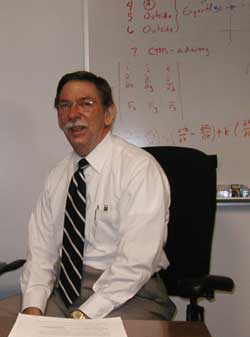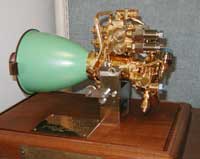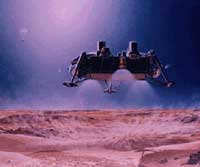 |
New Millennium Program's Chief Technologist,
Jack Stocky.
|
For a guy interested in exploring space and tinkering with the machines to get us there, Jack Stocky was definitely in the right place at the right time. With the ink still wet on his graduate degree from MIT in astronautics and aeronautics, Stocky arrived at JPL in 1965, just in time to get in on the exciting, ground-breaking work that paved the way for the Apollo Moon landings.
His first job was in the Surveyor Program. Although the Surveyor Program began for the purpose of sending scientific robotic missions to the Moon, its focus was shifted to test out landing technologies that could be used for the Apollo lunar landers, as well as to make close-up observations of the Moon’s surface that would help in designing the Apollo lander and in selecting landing sites. In 1966, Surveyor 1 was the first spacecraft to make a safe, soft-landing on an object beyond Earth. In 1967, Surveyor 7 was the first spacecraft to lift off from the Moon. Stocky’s primary specialty in fluid mechanics contributed to the successful development and validation of that propulsion technology.
 |
This pristine Vernier engine, identical to those used on the Surveyor spacecraft, has an honored place on Jack Stocky’s desk. Its purpose was to make trajectory corrections and slow the spacecraft for a soft landing.
|
 |
Artist Rendering of Viking 2 landing. At this stage of the descent, the lander's terminal descent propulsion system (three retro-engines) had slowed the craft down so that velocity at landing was about of 2 meters per second (7 mph).
|
Stocky was also in on Mariner and Viking, two other venerable programs in NASA’s history. Mariner produced ten spacecraft, 7 of which successfully completed their scientific missions exploring the inner solar system. Viking produced two Mars landers, Vikings 1 and 2, both of which successfully soft-landed on Mars in 1976 and proceeded to send back scientific observations for two and four years, respectively.
With the exception of a couple of relatively brief tours of duty elsewhere—a year at NASA Headquarters in Washington, D.C., as a NASA Detailee, and four years for Martin Marietta, working on external tanks for the Space Shuttle program—Stocky has remained at JPL. Among many of the projects he worked on was a science fiction-like type of rocket engine dubbed NSTAR (for NASA Solar Electric Propulsion Technology Application Readiness). Built by Boeing Electron Dynamic Devices, Inc. (formerly Hughes), the highly fuel-efficient ion engine eventually proved itself on the Deep Space 1 spacecraft.
Deep Space 1 was the first mission of the New Millennium Program (NMP), which Stocky joined shortly after its charter became clear in 1997. NMP was started as a joint effort of NASA’s Office of Space Science and Office of Earth Science to validate for use in space those advanced technologies perceived to be needed in the future to meet important goals of the scientific community for the space program. Stocky says, “We are a cog in the wheel that helps us realize important science information sooner than would occur if we did not do the technology validation.” As Chief Technologist for NMP, he says, “Part of my job has been to develop a clear understanding of what we mean by advanced technology and to be sure that the program does exactly that.”
But how does NMP know what scientists are going to need? What crystal ball can reveal whether solar sails, precision formation flying, aerocapture, or large space telescopes will be most needed? How do they decide among competing technologies and competing scientists’ wish lists which technologies to actually blast into space and put through their paces?
“We start our process for any mission by working with the science community,” Stocky explains. NMP wants to identify the capabilities scientists think they will need 15 years in the future. NMP works with scientists to identify key advanced technologies that would, if they were validated, bring those capabilities to fruition more quickly. NMP then solicits those technology advances from industry, academic, and government communities through competition. NMP selects the ones that promise to have the biggest payoff for the funds NASA invests in order to give the science community the largest values.
For now, Stocky is busy helping to define NMP’s Space Technology 8 and Space Technology 9 missions. ST8 will test light-weight deployable booms, lightweight deployable solar arrays, thermal control approaches for small spacecraft, and the performance of commercial off-the-shelf computer hardware in space. Although these technologies have already been selected, their providers have not. As for ST9, it will be a large system validation experiment with its own dedicated spacecraft. The specific technology to validate has yet to be selected.
“That process of figuring out what it is we ought to validate is the most interesting part of this job,” says Stocky. “There are clearly needs way beyond our ability to make a meaningful contribution—things that require hundreds of millions instead of tens of millions of dollars. There are also things that are too small for us. So it’s finding things that can make a real difference that’s important.”

